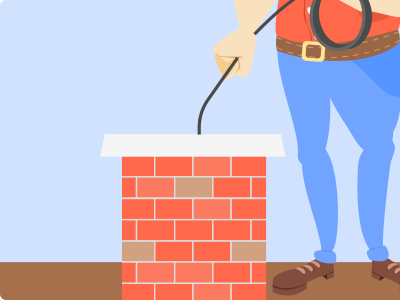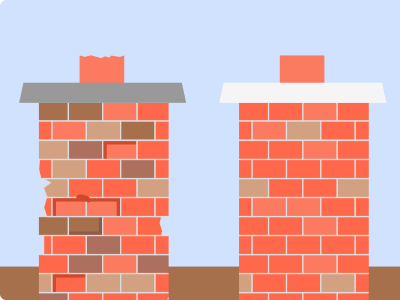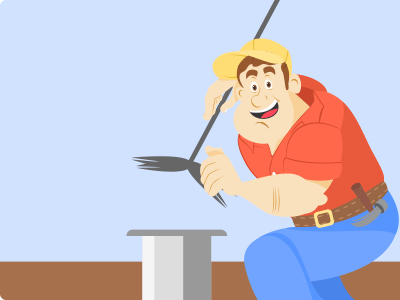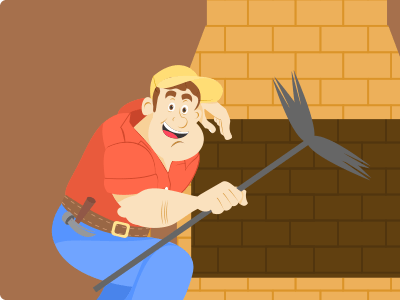
Chimney Sweeping
Back to topChimney Sweeping
As mentioned before, chimney sweeps nowadays rely on industrial equipment rather than actually entering a narrow passageway. Not only is it more convenient, effective, and safer, it allows for the job to be done more quickly. And with the added use of fiberoptic cameras, your sweep will know exactly where to look. Chimney sweeping isn't just convenient, it's a safety issue as well.
Back to topThe Industrial Vacuum
Usually a backpack or wheeled model for mobility, the industrial vacuum is the key component of the chimney sweep's arsenal. Specialized rigging allows for a modified intention on the head that makes cleaning chimneys a breeze. Often this can be the only system required to clean a residential chimney.
Back to topModern Brushes
Similar to the first chimney sweeping methods, sometimes old tricks are the best. Composed of thin wire brushes that extend from a narrow shaft, the brush is usually the best instrument in a chimney sweep's equipment for scraping off creosote deposits. This is especially true when the chimney sees frequent use, such as during the winter.
Back to topChemical Cleaners
Sometimes the creosote has become too oily or too slick to be scraped off, but can still remain combustible. In these cases it may be best to have an expert apply chemical cleaners to your fireplace. Not only will this break down the flammable materials that pose a threat, but it will help protect your chimney from further buildup in the future (2).
Back to topCreosote Deposits
The main point of chimney cleaning, besides ensuring that your home doesn't fill with smoke, is also to prevent the buildup of creosote (3). Creosote looks like a black, oily, tar-like condensate that occurs naturally inside chimneys and flues when wood is being burnt. Unfortunately the material is combustible, so proper maintenance is required to ensure that an uncontrolled fire does not occur. Some tips to help prevent creosote issues include (4):
- • Don't burn wood that was exposed to moisture - wood should be shielded from rain or snow
- • Only use your chimney as needed - Overuse will cause more buildup more rapidly
- • Make sure your flue is the right size - something too large will have more air as fuel for combustion
- • A chimney cap - will prevent draft and debris issues
- • Use seasoned firewood only - anything else could contribute to creosote buildup
Chimney Repair
If your chimney unit is compromised, that unfortunately can mean that your home is at risk for fire damage. To remedy this, call in a pro for chimney repair or chimney inspection right away. If you sense that smoke is being let into your home interior, certainly call in for repairs. Other warning signs include:
- • Missing or damaged mortar joints
- • Interior issues
- • Spalling bricks
- • Huge cracks or chips in the masonry
- • Rust stains
- • Crown issues
- • Damaged firebricks
- • Flashing
Fireplace Cleaning
Typically this is done after every fire, but sometimes you'll want a little extra done by a professional to make sure the area is safe for use. cleaning is different from chimney cleaning because while still a regular part of maintenance, this has to be done constantly and consistently to avoid accidental fires starting. Here's a quick breakdown of what's involved (5):
- • Wait for the fire to be completely out (don't pour water on it, it'll smoke)
- • Using flame resistant gloves, remove all large pieces of wood from the fireplace
- • Using a metal bucket and a metal dustpan, sweep the ash into the bucket
- • Transport the ashes to another metal container outside the home
- • Brush off the rest of the fireplace
- • Re-set the mantle for the next fire
Venting
Because the industry has changed to much since the days of old Britain's times. Many chimney sweeps also offer venting services to go with your source of household heating as well. So if you're looking to have alternative heating sources looked at for efficiency purposes, chimney sweeps can also examine the following heaters for proper venting.
- • Heating oil
- • Natural gas
- • Wood
- • Pellet
CSIA
The Chimney Safety Institute of America is the organization dedicated to informing people about chimney safety in order to prevent home fires. They are a nonprofit organization spearheaded by volunteers and concerned citizens who lead the country in training, educating, and certifying chimney sweeps and other such professionals (6). So if you have questions or concerns about safety, or if you have doubts on a certain sweep's credibility, this would be the organization to contact.
Back to topNCSG
Conversely, the National Chimney Sweep Guild handles things that aren't related to the consumer base. The NCSG provides standards, networking, and representation to its members and attempts to build a better community of qualified chimney sweeps. For homeowners, this means that anyone carrying an NCSG approval will be reliable, credible, and have a literal code of ethics for their work (7). They also try to answer any questions you have concerning your heating source and hot it works in your home.
Back to topHistory
The very first chimneys began to appear in Roman homes during the 12th century (8). They didn't begin to gain popularity in Great Britain until the 17th century and started to become a major industry. Many people know that the first chimney sweeps were actually orphaned boys performing hard labor under worse conditions (9). The phrase "to light a fire under you" stemmed from the literal act of a sweep master starting a small fire to coax a child from out of the chimney whose strength was depleted. Because of the terrible conditions the children were forced to endure, this led to a wide range of legislation that was passed in the 1800's (10). Unfortunately, many of the laws were promptly ignored due to a lack of enforcement.
Back to topThings to Avoid
There have unfortunately been a few rumors on how to care for your chimney that are not only inaccurate, but also incredibly dangerous to your household. Some of these false tips may have stemmed from older traditions, and some seem to be completely made up (11). In any case, please do not perform any of the following actions:
- A pine tree is not a substitute for a chimney brush.
- Do not burn potato peels on your logs.
- Under no circumstances should you drop a burlap sack filled with bricks down your chimney.
- Do not throw salt on your logs after burning them.
- Under no circumstances should you ever start a chimney fire in the shaft of the chimney. This will not serve any legitimate purpose in cleaning your chimney and in fact can lead to a house fire.
- Do hire a professional to clean and maintain your chimney
- Do uphold all laws and guidelines on chimney maintenance
References
- "Modern Chimney Cleaning". Wikipedia. Retrieved 9 August 2017.
- "Flue & Chimney Cleaning Chemicals". SFGate. Retrieved 9 August 2017.
- "Creosote Deposits & Fire Hazards in Chimneys". Inspectapedia. Retrieved 9 August 2017.
- "Minimizing Creosote Buildup in Your Chimney". Smoke Signals. Retrieved 9 August 2017.
- "Tips on Cleaning and Maintaining a Fireplace". DIY Network. Retrieved 9 August 2017.
- Brewer, Jim. Eldridge, Ashley."The Homeowner's Guide to Chimneys, Fireplaces, and Woodstoves". CSIA. Retrieved 9 August 2017.
- "Code of Ethics". NCSG. Retrieved 9 August 2017.
- Butler, Orville."Smoke gets in your Eye: The Development of the House Chimney". The Ultimate History Project. Retrieved 9 August 2017.
- "A History of Chimney Sweeping". Sweepy Stories. Retrieved 9 August 2017.
- "Key dates in Working Conditions, Factory Acts Great Britain 1300 - 1899". The Potteries. Retrieved 9 August 2017.
- "9 Kinds Of Wood You Should NEVER Burn". Organic Life. Retrieved 9 August 2017.
Select your Chimney Sweeping project
Service Cost Calculator
Enter service and
zip code to view
cost breakdown








